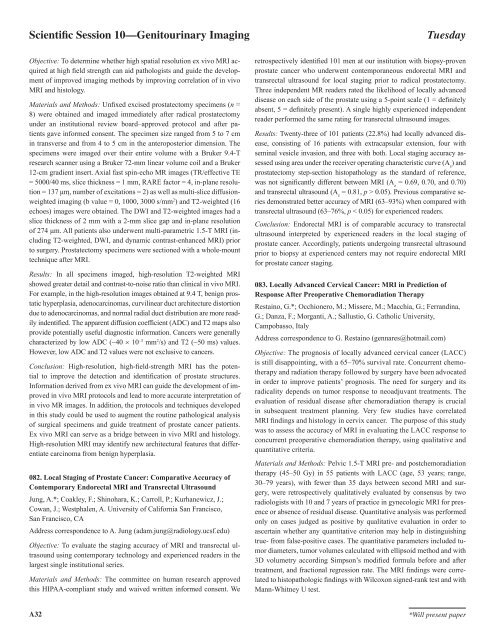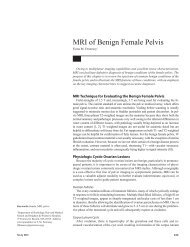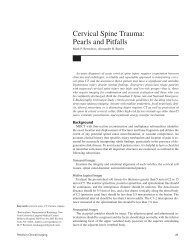Scientific Session 1 â Breast Imaging: Mammography
Scientific Session 1 â Breast Imaging: Mammography
Scientific Session 1 â Breast Imaging: Mammography
You also want an ePaper? Increase the reach of your titles
YUMPU automatically turns print PDFs into web optimized ePapers that Google loves.
<strong>Scientific</strong> <strong>Session</strong> 10—Genitourinary <strong>Imaging</strong>TuesdayObjective: To determine whether high spatial resolution ex vivo MRI acquiredat high field strength can aid pathologists and guide the developmentof improved imaging methods by improving correlation of in vivoMRI and histology.Materials and Methods: Unfixed excised prostatectomy specimens (n =8) were obtained and imaged immediately after radical prostatectomyunder an institutional review board–approved protocol and after patientsgave informed consent. The specimen size ranged from 5 to 7 cmin transverse and from 4 to 5 cm in the anteroposterior dimension. Thespecimens were imaged over their entire volume with a Bruker 9.4-Tresearch scanner using a Bruker 72-mm linear volume coil and a Bruker12-cm gradient insert. Axial fast spin-echo MR images (TR/effective TE= 5000/40 ms, slice thickness = 1 mm, RARE factor = 4, in-plane resolution= 137 μm, number of excitations = 2) as well as multi-slice diffusionweightedimaging (b value = 0, 1000, 3000 s/mm 2 ) and T2-weighted (16echoes) images were obtained. The DWI and T2-weighted images had aslice thickness of 2 mm with a 2-mm slice gap and in-plane resolutionof 274 μm. All patients also underwent multi-parametric 1.5-T MRI (includingT2-weighted, DWI, and dynamic contrast-enhanced MRI) priorto surgery. Prostatectomy specimens were sectioned with a whole-mounttechnique after MRI.Results: In all specimens imaged, high-resolution T2-weighted MRIshowed greater detail and contrast-to-noise ratio than clinical in vivo MRI.For example, in the high-resolution images obtained at 9.4 T, benign prostatichyperplasia, adenocarcinomas, curvilinear duct architecture distortiondue to adenocarcinomas, and normal radial duct distribution are more readilyindentified. The apparent diffusion coefficient (ADC) and T2 maps alsoprovide potentially useful diagnostic information. Cancers were generallycharacterized by low ADC (~40 × 10 –3 mm 2 /s) and T2 (~50 ms) values.However, low ADC and T2 values were not exclusive to cancers.Conclusion: High-resolution, high-field-strength MRI has the potentialto improve the detection and identification of prostate structures.Information derived from ex vivo MRI can guide the development of improvedin vivo MRI protocols and lead to more accurate interpretation ofin vivo MR images. In addition, the protocols and techniques developedin this study could be used to augment the routine pathological analysisof surgical specimens and guide treatment of prostate cancer patients.Ex vivo MRI can serve as a bridge between in vivo MRI and histology.High-resolution MRI may identify new architectural features that differentiatecarcinoma from benign hyperplasia.082. Local Staging of Prostate Cancer: Comparative Accuracy ofContemporary Endorectal MRI and Transrectal UltrasoundJung, A.*; Coakley, F.; Shinohara, K.; Carroll, P.; Kurhanewicz, J.;Cowan, J.; Westphalen, A. University of California San Francisco,San Francisco, CAAddress correspondence to A. Jung (adam.jung@radiology.ucsf.edu)Objective: To evaluate the staging accuracy of MRI and transrectal ultrasoundusing contemporary technology and experienced readers in thelargest single institutional series.Materials and Methods: The committee on human research approvedthis HIPAA-compliant study and waived written informed consent. Weretrospectively identified 101 men at our institution with biopsy-provenprostate cancer who underwent contemporaneous endorectal MRI andtransrectal ultrasound for local staging prior to radical prostatectomy.Three independent MR readers rated the likelihood of locally advanceddisease on each side of the prostate using a 5-point scale (1 = definitelyabsent, 5 = definitely present). A single highly experienced independentreader performed the same rating for transrectal ultrasound images.Results: Twenty-three of 101 patients (22.8%) had locally advanced disease,consisting of 16 patients with extracapsular extension, four withseminal vesicle invasion, and three with both. Local staging accuracy assessedusing area under the receiver operating characteristic curve (A z) andprostatectomy step-section histopathology as the standard of reference,was not significantly different between MRI (A z= 0.69, 0.70, and 0.70)and transrectal ultrasound (A z= 0.81, p > 0.05). Previous comparative seriesdemonstrated better accuracy of MRI (63–93%) when compared withtransrectal ultrasound (63–76%, p < 0.05) for experienced readers.Conclusion: Endorectal MRI is of comparable accuracy to transrectalultrasound interpreted by experienced readers in the local staging ofprostate cancer. Accordingly, patients undergoing transrectal ultrasoundprior to biopsy at experienced centers may not require endorectal MRIfor prostate cancer staging.083. Locally Advanced Cervical Cancer: MRI in Prediction ofResponse After Preoperative Chemoradiation TherapyRestaino, G.*; Occhionero, M.; Missere, M.; Macchia, G.; Ferrandina,G.; Danza, F.; Morganti, A.; Sallustio, G. Catholic University,Campobasso, ItalyAddress correspondence to G. Restaino (gennares@hotmail.com)Objective: The prognosis of locally advanced cervical cancer (LACC)is still disappointing, with a 65–70% survival rate. Concurrent chemotherapyand radiation therapy followed by surgery have been advocatedin order to improve patients’ prognosis. The need for surgery and itsradicality depends on tumor response to neoadjuvant treatments. Theevaluation of residual disease after chemoradiation therapy is crucialin subsequent treatment planning. Very few studies have correlatedMRI findings and histology in cervix cancer. The purpose of this studywas to assess the accuracy of MRI in evaluating the LACC response toconcurrent preoperative chemoradiation therapy, using qualitative andquantitative criteria.Materials and Methods: Pelvic 1.5-T MRI pre- and postchemoradiationtherapy (45–50 Gy) in 55 patients with LACC (age, 53 years; range,30–79 years), with fewer than 35 days between second MRI and surgery,were retrospectively qualitatively evaluated by consensus by tworadiologists with 10 and 7 years of practice in gynecologic MRI for presenceor absence of residual disease. Quantitative analysis was performedonly on cases judged as positive by qualitative evaluation in order toascertain whether any quantitative criterion may help in distinguishingtrue- from false-positive cases. The quantitative parameters included tumordiameters, tumor volumes calculated with ellipsoid method and with3D volumetry according Simpson’s modified formula before and aftertreatment, and fractional regression rate. The MRI findings were correlatedto histopathologic findings with Wilcoxon signed-rank test and withMann-Whitney U test.A32*Will present paper
















